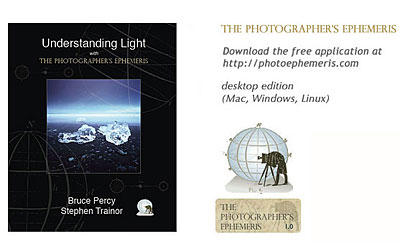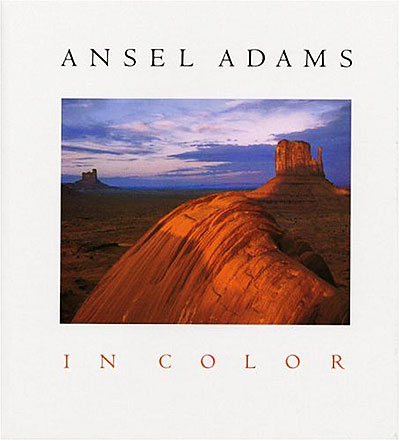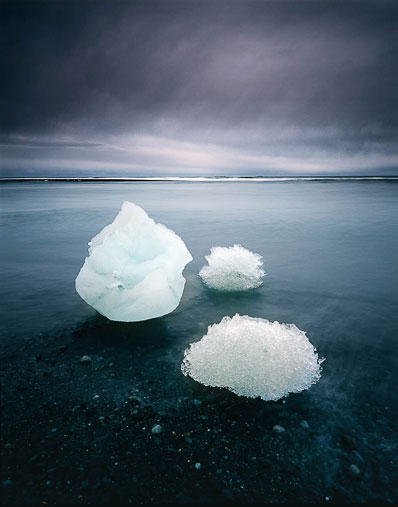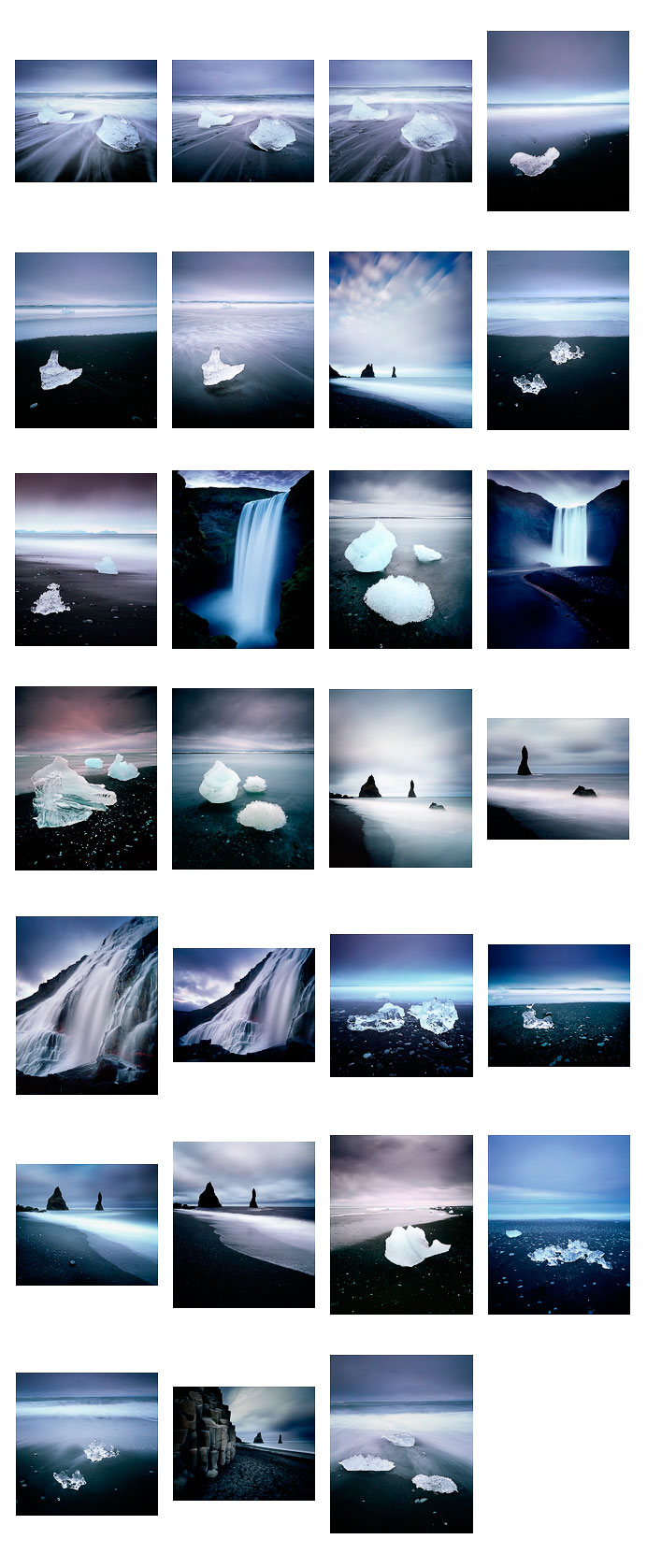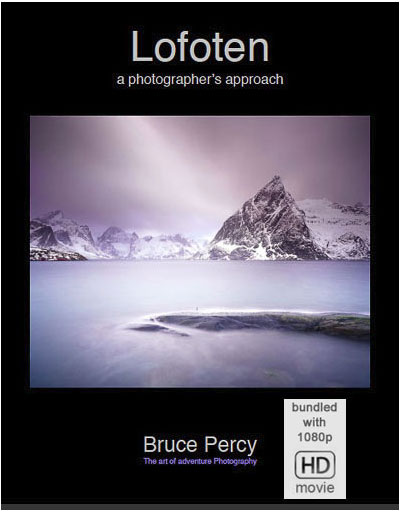I'm pleased to confirm that I will be giving a talk (40 minutes) at the Scottish Natural Heritage photography fair this September (both days - Saturday the 3rd and Sunday the 4th). The fair is held in Battleby near Perth, Scotland. If you'd like to come and see me talk about my travels and photography, you can book tickets on the SNH site. I am attending both days.
Understanding Light
I'm really excited to let you all know that at the end of the week, Understanding Light with the Photographer's Ephemeris, will be released. Notification about the release of this eBook will be first notified through my monthly news letter. If you're not a member of my news letter - you can subscribe on my home page.
Both Stephen Trainor (the creator of the Photographer's Ephemeris) and myself have been working on this eBook for quite some time - it's been quite a journey, initially starting off with me trying to put something together last year about the application, and then Stephen getting involved. We both feel it's a really good read now.
If you don't know what the Photographer's Ephemeris is, it's a really useful application I use to plan some of my landscape photography shoots. It provides information on sunrise and sunset times, twilight times, angle of sun and direction of sun throughout the day too. If you'd like to read more about it - then please go to Stephen's web site where you can also download the free desktop edition of it.
It's also available for the iPad and iPhone - my favourite version is the iPad version, which is great for taking with you while you're out and about.
Anyway, just a little heads up to keep an eye on your inbox this week for news of the eBooks release.
Ansel Adams in Colour
I've been pretty quiet of late on my blog, and this has been for good reason. The past few weeks since I returned home, I've been busy preparing my first cloth bound book for printing. It's been a long haul, but I think that anything worth doing, should be done properly.
Doing a book requires a lot of preparation. You may think the choice of images would be the hardest part, but it's been a huge learning curve.
Firstly there is the cost of doing a book, learning about paper types and also, getting past the jargon that printers talk in. There is also the question of storage and distribution to overcome - where exactly do you store 1,000 books?
The good news is that the Quark express file is almost ready now. I spent the early part of this week in Nottingham with my friend Darren putting the layout together. We've got some beautiful fonts in there and the layout is simple yet elegant. The ISBN number has been allocated and the preface has been written by someone whom I admire the work of greatly. The book will be released by Half-Light Press. Estimated release date is the later half of October, early November, but I will preview a proof copy of the book on this blog when the printer sends me one.
So why the title 'Ansel Adams in Colour'? Well, I guess the past few weeks, as I've been busy looking at samples of paper types to use for my own book ( I have settled on a fine Japanese art paper), I've been busy plundering my ever growing collection of fine photography books for comparisons. One such title that I hadn't looked at for a long time is Ansel's book about his colour photography.
Apart from the fact that it's beautifully printed on the finest stock Silk paper I can imagine, I'd almost completely forgotten that Ansel shot colour at all.
This brings up an interesting aspect for me. I feel that photography that is considered 'art' is often black and white. Certainly, I'm in awe of the medium, despite that I don't shoot it myself. But what of Colour? Why has it not been embraced so steadily by the photographic art world? Well, I think if we look inside Adam's book, it's clear to me that Ansel had trouble with the medium. That's not to say his work was bad. It's rather beautiful in fact to see very Adams-like compositions, but done in colour. The thing is though - he was troubled because he lacked the degree of control that he wanted over colour. Ansel was no black and white purist, and is often noted to have looked forward to the digital revolution and the means to control colour the way he wanted to. I feel that perhaps, since the amount of dark-room control that was ever present for Black and White, allowed it to establish itself more than Colour could. Colour has been a late developer (no pun intended).
So what of Ansel's book. It's a great read. It's also interesting to see how he grappled with the problems of working with early colour and how he failed (too strong a word) to reach his vision with the medium. I personally think this book is a very important document, illustrating the trials of colour, how it was perceived by the generation of the 40's and 50's.
Maybe you didn't know that Ansel had made colour images? If so, then I can recommend this book as it's a beautiful edition and I feel, should be part of every landscape photographer's 'core' book collection.
It turns out that the book has been revised and expanded since my early 90's edition, and unfortunately - is now out of print. So if you're interested in this title, my review is based on the 1st Edition, and you can get a copy of it on AbeBooks.com.
All Quiet
I just thought I'd post here tonight, that my blog has been pretty quiet of late.
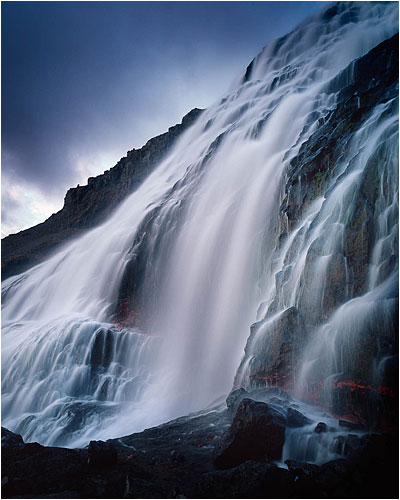
I'd just like to tell you all that when you see little activity on my blog, it's because I have to focus my attention on other issues. In other words, what might appear to suggest little or no activity, in reality is the opposite. I've been spending a lot of time over the past few weeks working on my book. The text has been proof read, double proof read, and now going through a third proof reading. The ISBN numbering and publishing has been registered with Neilsons here in the UK. The art work has had to be revisited. Images have had to be optimised for off-set press and prefaces have to be written by very special people.
I'm off to Norway on the 25th of this month, I'll be away for 2 weeks and I hope to have some new images to share with you then.
Anyway, I guess I'm just aware that I've been pretty quiet of late. It's not intentional. It's just that there's a lot going on in the background.
Variants on a theme
One thing I feel is worth pursuing is the idea of a theme in my photography. I like to photograph the same subject from different vantage points, often returning again and again, because the light will differ, or something I never noticed before becomes more prominent.
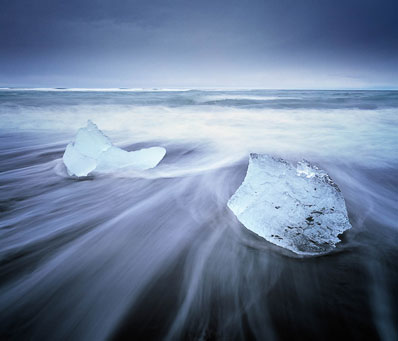 But sometimes I shoot several images at the same location within a matter of minutes. I'm never economical with film. It's a storage mechanism for holding what I saw whilst there. So for me, film costs have never been an issue. I want to create good (if not great) art, so financial constraints of how much film I use doesn't even come into the equation. Likewise, even if I feel I've already got a composition nailed, I'll still continue to work with a scene, or a group of objects because simply put - I feel there's still untapped potential.
But sometimes I shoot several images at the same location within a matter of minutes. I'm never economical with film. It's a storage mechanism for holding what I saw whilst there. So for me, film costs have never been an issue. I want to create good (if not great) art, so financial constraints of how much film I use doesn't even come into the equation. Likewise, even if I feel I've already got a composition nailed, I'll still continue to work with a scene, or a group of objects because simply put - I feel there's still untapped potential.
I think we have to be aware of our surroundings all the time. We have to be open to suggestion. As much as I love to work on a group of objects within the scene, I know when enough is enough. I also know that tantilisingly, there may be an even better image awaiting my discovery only just a few feet away from where I'm standing. I never understand why someone wishes to shoot the exact same spot for the entire session. But likewise, I never understand it when someone shoots only one image of a scene and thinks it's enough. Each piece of scenery that resonates with me, often requires a few attempts to get the best out of it. I sometimes find that what I intended to capture turns out to be a half-baked idea compared to the final composition I end up with. The first image is perhaps just my introduction to a subject. It is an advertisement that draws me in. And once it has my attention, I begin to discover so much more about it.
Photography is a balancing act between haste and stagnation. Being flexible enough to keep moving, but also having the experience, or temperament to stay put and work with a subject and explore its many possibilities, is a fine skill to possess.
Evolution, Progression
I've just been spending a bit of time re-organising the contents of my web site. It's allowed me to review my own work quite a bit, and notice that there has been a progression - maybe considerably over the past two to four years.

I tend to spend a lot of time considering how things are. I have a streak of introvert about me which causes me to re-evaluate things on a frequent basis. Many people I feel, simply go about their lives without really considering just how far they've come. We do tend to spend a lot of time in the past and a lot of time thinking about where we want to be, but seldom do we really actually manage to sit comfortably in the present and enjoy it for what it is. I think that's what photography allows many of us to do: remove all the clutter from our minds - bills to pay, memories of past events, dreams of the future, and just exist.
But I think as photographic artists, we should take time every now and then to re-evaluate just what sort of photographer we are. I'm certainly aware that my style has been heading towards a more simplistic approach over the last few years. I also think my choice of colours is toning down a bit too. Maybe that's just a current thing for me. One day you feel you want to go one way with your work, another day you may interpret it in a very different way, simply because of how you feel.
We are dynamic after all.
Things are fluid, always in a state of change, and style can progress, stagnate as well as retreat back to an earlier style. Nothing should be cast in stone and I think we should be willing to forgive ourselves for any errors we have made. Because they're not really errors. We feel, we react, we produce work. Another day we are a different person and we respond and react in a different way.

So I've been going back over some of my earlier work and I'm almost tempted to bin a huge section of it. It embarrasses me to some degree. What I felt was good, I now feel a sense on unease about.
There is also, a temptation to go back and rework some images, but that way, I feel - lies madness. I'm not overly keen on music artists that I like revisiting their earlier work - simply because it smells of someone who can't leave something alone, and who can't move forward (even though I do believe every artist has the right to do whatever they feel with their own work).
But I mustn't be too hasty. It is, after all, this older work that has allowed me to do the re-evaluation I've just been describing. It is the basis for me noticing that my photography is constantly evolving and (hopefully) progressing.
And that is a good thing.
Postscript: A note about the first image you see in this article. Near the river outlet to Jökulsárlón lagoon in south east Iceland, bergs enter the sea. Each day there are different shapes and sizes of bergs littering the black sand and the view out into the atlantic. Occasionally you see some seals in Jökulsárlón lagoon and out in the sea too. It only occurred to me today whilst posting this image, that the little seal-sculpted out of ice is a nice metaphor for the seals in Jökulsárlón.
Further, the last image of Skógarfoss was my attempt to improve on the standard view that I keep seeing in everyone's portfolios of this location. Often I feel the foreground is a little boring, and with such a huge wall of water, what are you supposed to do with the composition? So I actually waded out into the ice cold water to get this curve in the foreground. I just felt the black sand on its own wasn't particularly captivating enough. I'm always looking for a bolder statement. Aim for 100% and you'll maybe get 70%. Aim for something extra special, and you may just get something better than 'ok'.
Iceland 2011
Only shoot when you feel inspired by what you're seeing.
But what if you're feeling so crappy, that it's hard to muster up the effort to get up and go out and shoot?
Of course there can be many reasons for not going out to shoot images. Work pressures, family commitments, a bad cold, of simply not feeling inspired to go out.
I always felt that if I was feeling uninspired, then it would show in the final images. That's true to some extent. When I was an amateur photographer in my early 20's, I'd be so keen to go out and make images, that I'd convince myself that something magical would happen between me clicking the shutter at a rather mundane scene and the final transparencies coming back from the lab (these were the days when you didn't really know what you'd get back, because film always looks different from what the human eye can see). But I'm of course further on in my photography, and I've come to recognise when it's not happening. I a nutshell: I know when to stop, or when to not even bother.
But I find it so easy to talk myself out of going to make images. 'It won't be any good', or 'I feel pretty bored', or in the case of this recent trip to Iceland 'I feel like my head is going to fall off with the cold, so I'll just stay in my tent'.
This is, to some degree, a form of procrastination.
I'm sure now, having seen the results from my trip, that I could have done more. I know I could have done more and I also recognise that although having a bad chest infection didn't help me feel that great, it didn't damage what I was feeling for the landscapes around me. It just stopped me from continuing on with my journey and cutting it short.
But every cloud has a silver lining, and I've learnt something about myself and my photography. I've learned that a form of pessimism can creep in when i'm not feeling great. It colours my outlook and any realistic barometer that I have (call it skill, intuition, whatever). I've also learned that if I keep going (not driving my health into the ground), but work towards making images, something will come.
Travel photography is hard work. I put 200% into making images when I'm away. I think most people who want to make good images in a foreign land don't really appreciate this fact. Travel photography is a major commitment and it takes a lot out of you.
Rewarding though it is.
ps. The Iceland portfolio is now on-line if you wish to have a closer look.
pps. Click on the contact sheet above for a nicer view.
Jökulsárlón
Today I just sent out my newsletter with some images from Iceland. I'm in the middle of working on them at the moment. But while I do, I thought I'd just post this one tonight for you.
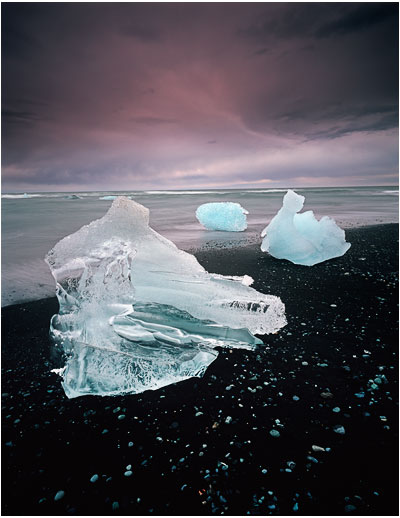
Black sand beaches and crystal clear ice bergs are something to witness. But maybe not so great when your head is stuffed with the cold. Anyway, I'll be putting some more images up once I've completed scanning them. Expect a contact sheet in a day or so from here.
But I'd just like to say before I go tonight that I'll be heading back to Iceland this December / January to spend more time in the south of the country. Visiting the same locations under different light (daylight is 3 or 4 hours at that time of year), with a low sun, can show a new face to an already familiar subject.
Onwards
Well I've been home for a few days now, from what turned out to be perhaps the most awful trip I've experienced to date. Everything seemed to go terribly wrong, all starting with getting a chest infection from the moment I landed in Iceland. They are also experiencing the coldest summer since 1958. It was cold. Plus, I have to say that going during the longest days of the year is not to be advised from a light / photographer's point of view. It never really got into Twilight at any point and I felt that the light never really got sweet enough to photograph in. Just a shade too close to midday light for my liking, even at midnight or 2am.
However, I did stumbled out of my tent at Jokulsarlon (glacial lagoon) to make some photos of the ice bergs crashing on the black sand at the coast line. I must admit that I felt like hell while I was out there making pictures and retreated back to my tent after only about half an hour. I was feeling so crappy, that I completely lost the will to make any concentrated effort on my photography.
Strangely, I've come home with around 17 rolls of film shot, and I suspect that there will be some decent images in there, despite my own interpretation of how bad the trip was.
So I'm wondering if I actually managed to make some good images after all? Being ill definitely made me feel less enthused to make images and I often found myself feeling very disconnected from what I was there to shoot. But I rarely make an image if I'm feeling I'm just going through the motions, or have little interest in what I'm doing. So how come I've managed to shoot 17 rolls of film?
My theory is that perhaps there were those moments of inspiration. But because I'm so clouded by an overall impression of how bad I felt for most of the time, I've lost sight to those sparse moments I had when I felt really good about what I was doing?
Time will tell. I've posted off my films at the moment and hope to have some to work on early next week. I'll post some on the blog if I feel inclined to do so.
Anyway, It's back to work for me at the moment. I've got a lot going on this month with the Quark Express file being created for my forthcoming book this July, and I'm busy proofing the images for the book at home while the text is now finally being proofed by someone (after a few false starts at trying to get it checked over by several people this year). So things now feel like they're going ahead.
Lofoten - a photographer's approach
For those of you who aren't a member of my news letter, I've just released a new eBook - Lofoten - a photographer's approach. This is perhaps my most favourite writing project to date, because it has nothing to do with the technical side of making images, but instead, is about approach. It was great fun to write it because I had to relive the experience of being back on Lofoten and just how everything there - the people, the weather, the quality of light, and how I felt about being there - all came together and resulted in the final images you see within the eBook.
I think how we approach and deal with a subject is more important than knowing which f-stop to use, or what shutter speed to use. I believe that being more aware of our surroundings, and heightening our sense of awareness is vital if we are to improve in our photographic endeavours.
Anyway, that said, I'm sure that the sales of this title will be a lot smaller than the techy books, simply because of the demographic involved. Many people own cameras, but don't consider themselves artists, while proportionally, few artists own cameras.
Learning the technical helps, but it doesn't make us great photographers. If only learning the techy stuff was all we needed, then it would be great wouldn't it? Actually, no it wouldn't, because what makes photographers stand out, is the differences in how they see and how they respond to what they're experiencing.
You can get 'Lofoten - a photographer's approach' alongside a 1080p version of the related podcast here.
--


